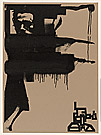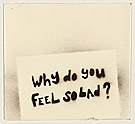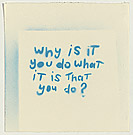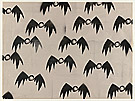Return of the hand
In recent years, some of the most exciting aesthetic experiments that have kept the Australian street art scene kicking indicate a return to a number of traditional art forms. In contrast to the monumental, heroic and often ultra‑masculine characteristics of much graffiti and street art, many artists are now choosing to use hand‑drawn and painted posters, cut paper, watercolour, linocuts, etching and paper collage to express themselves in multiple styles that have formed the newest chapter in Australian street-inspired creativity. Setting up a deliberate opposition between the fast‑paced, noisy rush of the concrete city and the delicate and often labour‑intensive creations of the human hand, many of these works focus on the fragility of paper creativity, on decay, and on decorative patterns and surface detail. In moving into the gallery space, this group of artists has found new inspiration in folk and popular art. Artists are developing imagined narratives and using dreams, nightmares and childhood fantasies as their subject matter.
We are now at an exciting point of transition between street and gallery that has been successfully navigated by many artists across the country and internationally. In the gallery system, we are witnessing a complex convergence of several street art forms into something that can be recognised as the next chapter in contemporary art – a hybrid permutation of style and meaning as street art within the gallery context converges with other forms of underground art such as tattooing, graphic novels, toys, punk illustration and hot‑rod Kustom kulture, even knitting. This new manifestation of street-inspired creativity is being redefined and critiqued as lowbrow, Pop Surrealist, neo‑Pop or newbrow forms of contemporary art. Whatever the definition, it is indisputable that the journey from ephemeral to collectable, and from the street to the gallery, is one that is both complex and multifaceted. Street art has launched a multi‑pronged invasion of public space as well as the white cube of the gallery, significantly altering Australian visual culture and announcing the arrival of a new generation of contemporary artists.
The street for me has a spontaneity and an energy about it that is the really enjoyable part of making. Whenever I feel like my gallery work is really lacking something, I go back into the street. You just do spontaneous things in the street that push you in other directions and that is something that I really vibe off. I haven’t made a conscious decision to stop doing street art but it is just one of those things that happens every now and then in life. I still live it and still observe it and will keep doing it, but you go through phases…I have had them before and I have come back to it, to start all over again.
Nails.Some art is best shown in galleries or in a publication or in a lounge room, and sometimes is best seen in an alley or a train or a doorway or freeway overpass. Some of the most interesting art, is when it is uncategorised or blurs and bleeds into different genres.
As far as street art informs my practice, its energy is what I have tried to harness—colour, rebellion, fun. The roots and energies of the street have been omnipresent but haven’t directly influenced the aesthetic. The methods and mediums of street art—spray‑paint, stencilling—have been engaged sporadically, but the outcome has never been a direct copy of what happens on the street. It has been more a definite evolution of an aesthetic into something completely different to what we recognise as street art.
Misha Hollenbach


![Misha HOLLENBACH | No still eye deer [panel C] | 2000](images/sml/167524.jpg)
![Misha HOLLENBACH | No still eye deer [panel B] | 2000](images/sml/167522.jpg)
![Misha HOLLENBACH | No still eye deer [panel A] | 2000](images/sml/167523.jpg)








